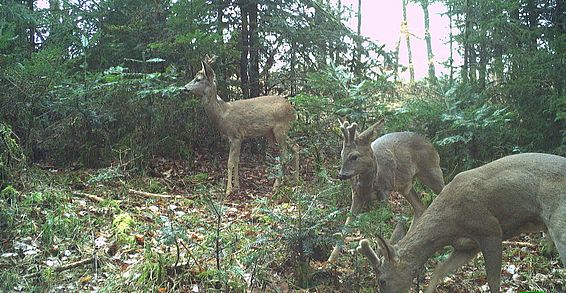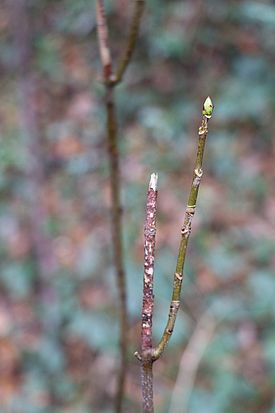26.09.2023 | Tamara Baumann | WSL News
In many Swiss forests, and especially in protection forests, there is a lack of tree regeneration. One reason is the impact of red deer, chamois and roe deer, which browse on tree saplings or rub their antlers against young trees. Andrea Doris Kupferschmid of the Swiss Federal Institute for Forest, Snow and Landscape Research WSL explains why this is so and what it means in view of climate change.
Terms with * are explained in the glossary below.
Ms Kupferschmid, what is the impact of wild ungulates on Swiss forests?
When roe deer, red deer and chamois browse the shoots of young trees or eat entire trees seedlings, this is called browsing. However, the animals do not browse all tree species equally, but selectively pick out those that they like. In this way, only some tree species grow into large trees. In the long term, browsing by wild animals can thus lead to changes in the species composition, i.e. to a segregation* of individual tree species.
Why is this critical?
Tree regeneration - that is, a new generation of trees growing up - is crucial for the composition of future forests. Tree regeneration significantly influences the stability and the ability of future forests to recover from stress or disturbance.
High impact of browsing leads to less diverse forests, which is bad both in terms of biodiversity and protective forest effect. For example, pure spruce forest stands are much more susceptible to bark beetles infestations than mixed forests with spruce, silver fir and sycamore maple. The latter two species also withstand storms and drought better than spruce. If the old stand* dies and too little tree regeneration grows up, expensive barriers against natural hazards have to be built in protection forests. There is a whole chain of consequences for the forests if individual or even all tree species can no longer grow up as a result of the influence of wild animals.
Also with respect to climate change?
Yes, exactly. Climate change will bring more extreme events such as storms, mass propagations of beetles, drought and heat. Mixed stands* - i.e. species-rich stands - can withstand such disturbances better than pure stands*. Many beech forests, for example, have a problem when it gets dryer, as beech is susceptible to drought. One should promote more drought-resistant trees there, such as oak, cherry, maple and hornbeam.
However, we observe that ungulates prefer to browse or rub* their antlers against the tree species we need for the future. In beech forests, these are especially oak or maple, in mountain forests fir and rowan, and even higher up mountain pine or larch.
Has the influence of wildlife increased recently?
That is the case. On the one hand, the animals are increasingly forced to leave the open areas to take refuge in the forest. In particular, red deer and chamois mainly graze in the open countryside. But they can do this less and less in Switzerland. Since there is usually less food in the forests, they then also browse on trees there. But even in the forests, disturbances are increasing, especially from recreationists. The animals therefore retreat to areas with more cover, e.g. into thickets or regeneration stands.
On the other hand, ungulate populations in Switzerland have increased and the red deer has spread further. For decades already, we have a high level of browsing, as evidenced, for example, by the Swiss National Forest Inventory (link) carried out by the WSL. This means that in the meantime not only the very small trees are missing in certain forests but also the medium-sized trees that should take over protection against natural hazards in the immediate future.
In addition, many forest stands should become more diverse in order to ensure their functions in the longer term. Particularly important are tree species that we assume will cope better with warmer and drier conditions. However, precisely these are particularly prone to browsing, and thus more areas are now affected by the impact of wild animals.
At the political level, there is often talk of a forest-wildlife conflict. Why?
The conflict arises when gamekeepers or hunters are of the opinion that there are relatively little ungulates or that the animals do not pose a problem for tree regeneration. On the other hand, however, foresters observe that the tree species adapted to future climate are frequently browsed or rubbed on or frayed.
In principle, it is not a conflict between forest and ungulates, but a conflict between people who work in the forest and people who hunt or are gamekeepers. So, it is a human-human conflict. Roe deer, red deer and chamois - the ungulates - have no conflict with the forest.
That's where I see the solution: people have to talk to each other and approach each other. Then the conflict can be solved. If the problem is always blamed on the forest and the animals, no compromises can be found.
What are your recommendations for dealing with the forest-wildlife issue?
When it comes to implementation, measures should take effect at the local level and be adapted to local conditions. The local foresters and hunters know the forests and the ungulates best. It is therefore essential that the stakeholders on the forest and hunting side jointly develop and implement measures. They can, for example, enhance the habitat, create shooting corridors, organise focal hunts, carry out regeneration cuts, etc. These measures should be coordinated so that they jointly lead to the goal of promoting species-rich regeneration. The effect of the measures should be checked so that they can be supplemented or strengthened if necessary.
Both the Swiss Forest Act and the Hunting Act stipulate that the ungulate population must be regulated in such a way that the tree regeneration is ensured without protective measures (individual protection of trees, fences, etc.). Nevertheless, the situation has not improved in many areas and has even worsened in certain places. The authorities could promote a more consistent implementation of these laws by issuing forest-wildlife concepts. This is what Othmar Reichmuth's present postulate indirectly calls for. Furthermore, one could also introduce certain facilitations for hunting, for example, to allow hunting at other times.
How can research contribute to resolving these conflicts?
We try to show the actual wildlife influence in a neutral way, especially where the conflicting parties disagree. We do this with inventories, assessing the influence of browsing on tree regeneration on sample plots. In addition, we can create better methods for expert assessments and long-term monitoring and support the foresters in better assessing the influence of browsing. We refer to such methods, for example, in the current issue of the Swiss Journal of Forestry (SZF).
Influence of ungulates in Kirchberg SG stronger than assumed
Andrea Kupferschmid and her team have conducted several inventories on the influence of ungulate browsing, most recently in beech forests in Kirchberg SG. Her conclusion: "The animals had a greater influence than I expected." Only beech was frequently represented in all height classes*. The future tree species, i.e. species that are likely to cope better with the warmer and drier conditions caused by climate change, were almost only present in the smallest height class. For them, the observed browsing impact was stronger and more long-lasting than expected for beech forests.
The team found that trees browsed in winter often did not form a new terminal shoot* at the top in the following summer, i.e. they reacted to the browsing with a delay and thus their growth was stopped by one or even several years. And this did not only apply to tree species that were already known to be poorly able to cope with browsing, such as silver fir. In Kirchberg, browsing currently leads to reduced growth of those tree species that can cope better with the future climate and thus favours beech. Browsing thus negatively influences the development of these beech forests into climatically adapted mixed forests.
"This shows how important it is to concretely examine the influencing factors on a site. From this, the persons responsible can then derive the optimal measures in hunting and silviculture," says Kupferschmid.
See also:
https://www.waldwissen.net/de/waldwirtschaft/schadensmanagement/wildschaeden/auswirkungen-von-wildverbiss-in-buchenwaeldern-bei-kirchberg
*Glossary: The most important forestry terms on ungulate browsing
- Grazing, browsing: Feeding of wild ungulates.
- Impact of wild ungulates on forest trees:
- browsing: browsing is when roe deer, red deer or chamois eat shoots from young trees.
- When deer tear off the tree bark with their teeth in order to eat it, this is called bark stripping.
- When bucks scrape their antlers on trees, either to clean the antlers or to mark the territory, this is called rubbing. They usually do this on small trees about as thick as an arm, which may die completely or partially.
- Tree regeneration: The regrowth of young trees that form a new generation of trees.
- Stand: A sub-area of a forest that is similar in terms of species composition and ecology.
- Pure stand: Stand consisting of only one tree species.
- Mixed stand: Stand consisting of several tree species.
- Segregation: If certain tree species are more severely affected by browsing, they grow up less frequently and more slowly than other species. In the long term, these species can disappear completely from the stand. The mixed stand then contains fewer species or can become a pure stand.
- Height class: Classification of trees according to their size, e.g. 10 to 39.5 cm tree height, 40 to 69.5 cm tree height, 70 to 99.5 cm tree height and 100 to 130 cm tree height. From a height of about 130 cm (roe deer) to 2 m (red deer), tree growth is usually no longer influenced by browsing.
- Terminal shoot: The tip of the tree with which the tree grows upwards.
Contact ¶
About Andrea D. Kupferschmid ¶
Über Andrea D. Kupferschmid
Andrea Doris Kupferschmid has been researching the influence of wild ungulates on tree regeneration since 2004, since 2012 at WSL as a research associate in the Stand Dynamics and Silviculture Group. In her research, she aims to create an objective data basis on the Switzerland-wide influence of ungulates on local tree regeneration. Since 2020, she has also been working as a consultant on browsing by ungulates for Forest Protection Switzerland.
Publications ¶
Projekte ¶
Links and documents (in German) ¶
Schweizerische Zeitschrift für Forstwesen, Ausgabe 5/September 2023: Wildeinfluss auf den Wald
Waldwissen.net – Einfluss des Verbisses auf die Verjüngung besser beurteilen
Waldwissen.net – Auswirkungen von Wildverbiss in Buchenwäldern bei Kirchberg SG
Copyright ¶
WSL and SLF provide image and sound material free of charge for use in the context of press contributions in connection with this media release. The transfer of this material to image, sound and/or video databases and the sale of the material by third parties are not permitted.

